#Willem Wylde
Text
Every source text in and out of universe has the advantage of hindsight, so of course everyone is going “oh yes, Prince Baelor Breakspear was killed in the battle for the honor of the great Ser Duncan the Tall, who would soon rise to be Lord Commander of the Kingsguard”- no. Picture yourself at the time and place, and outside of Dunk’s POV. Half the royal family and some the greatest lords south of the Blackwater got into a murderous fight over some lanky commonborn teenager with a questionnable understanding of color theory. What even was on that shield. Who the fuck was that. People died
#literally the reason all of this happened is because Aerion wanted to make a mess and be in the middle of it#Duncan the Tall#Aegon V Targaryen#Aerion Targaryen#Daeron Targaryen (son of Maekar)#Maekar Targaryen#Baelor Targaryen (son of Daeron)#Roland Crakehall#Donnel of Duskendale#Willem Wylde#Steffon Fossoway#Robin Rhysling#Humphrey Beesbury#Humphrey Hardyng#Lyonel Baratheon#Raymun Fossoway#asoiaf#a song of ice and fire#dunk & egg#valyrianscrolls
469 notes
·
View notes
Photo




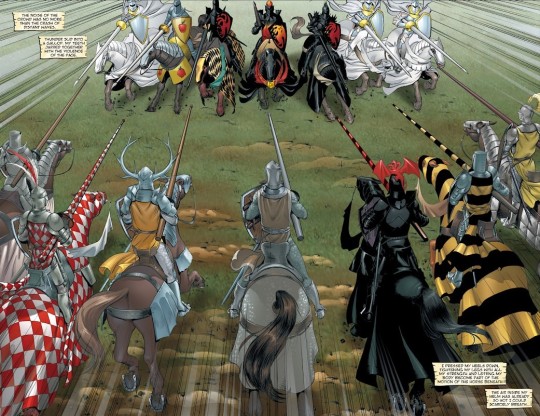
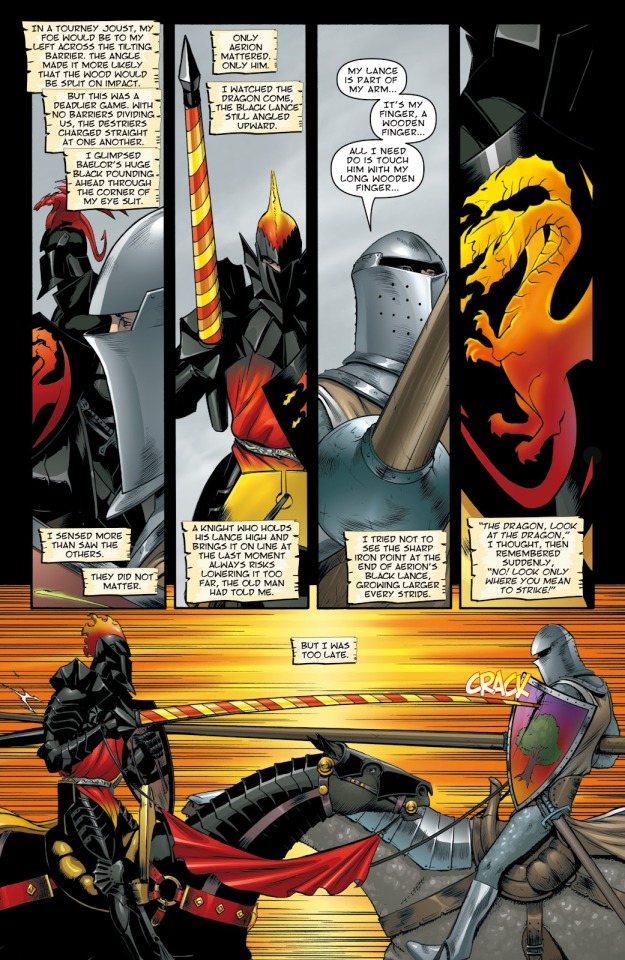
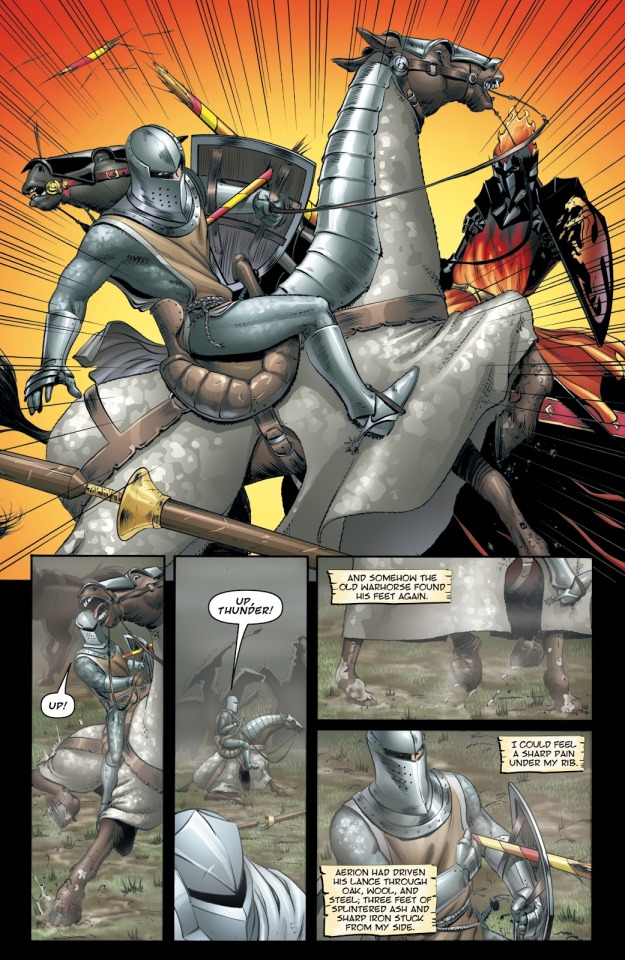
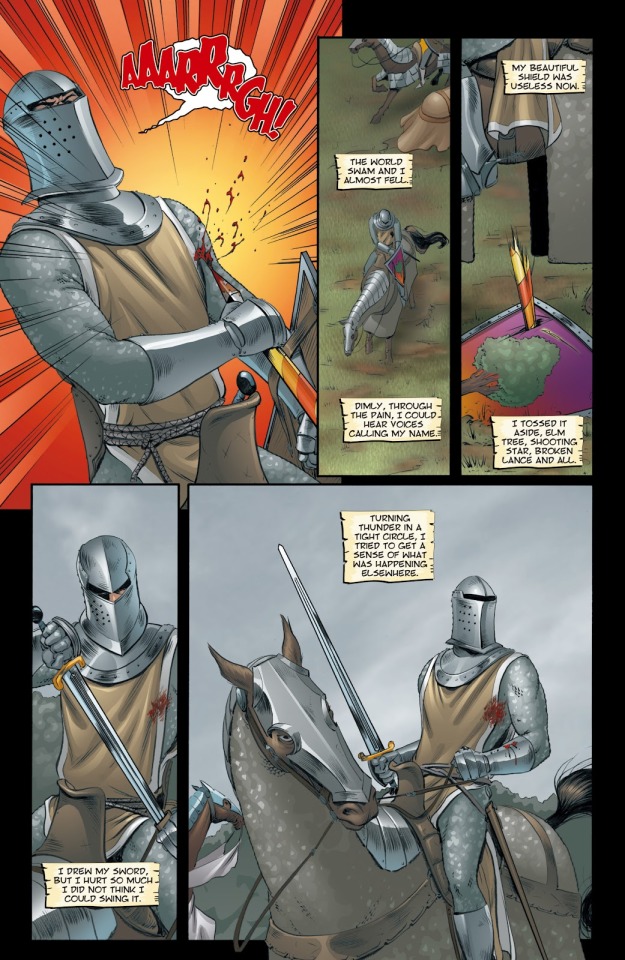

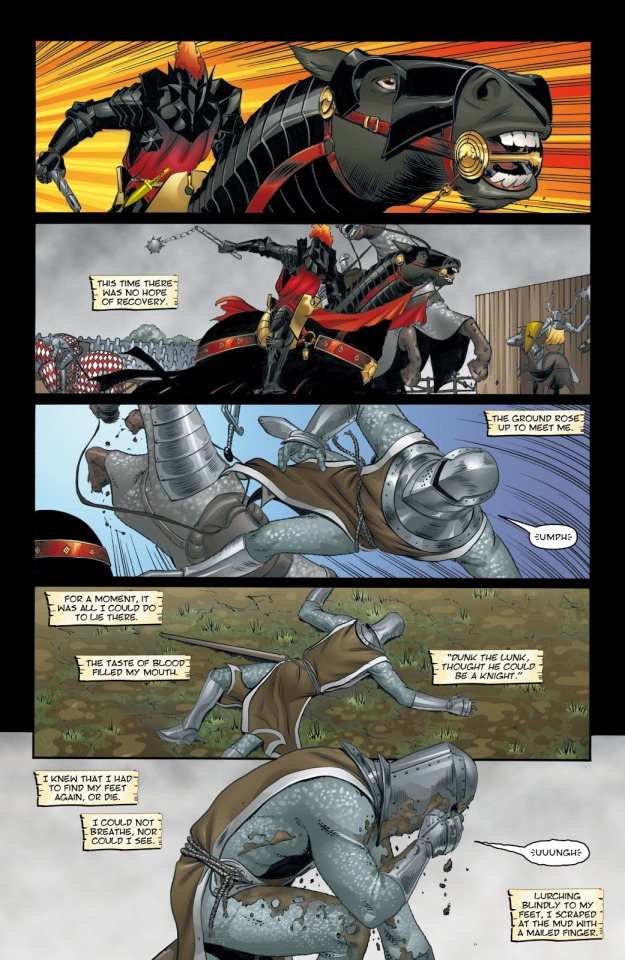

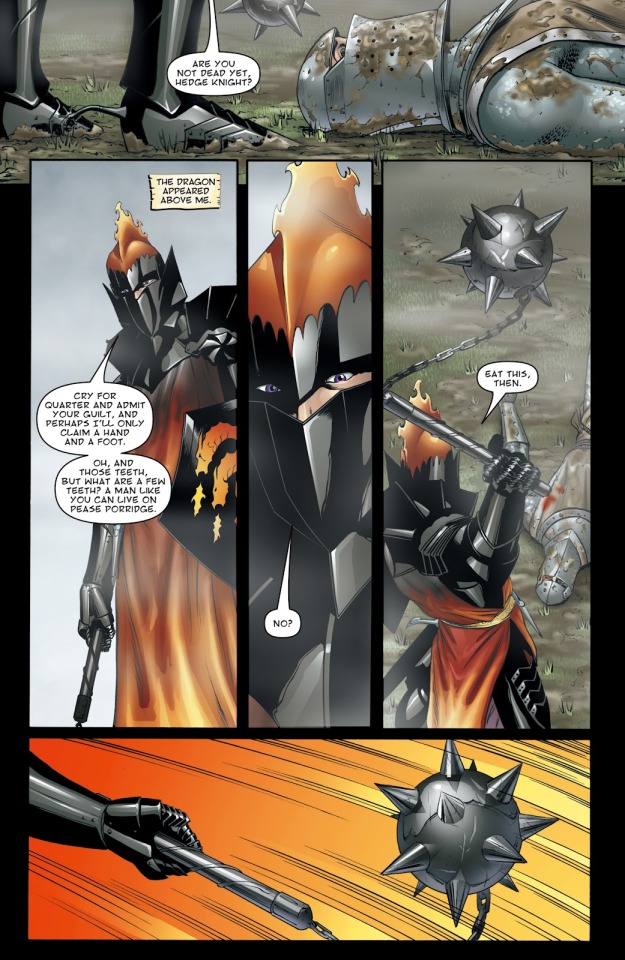
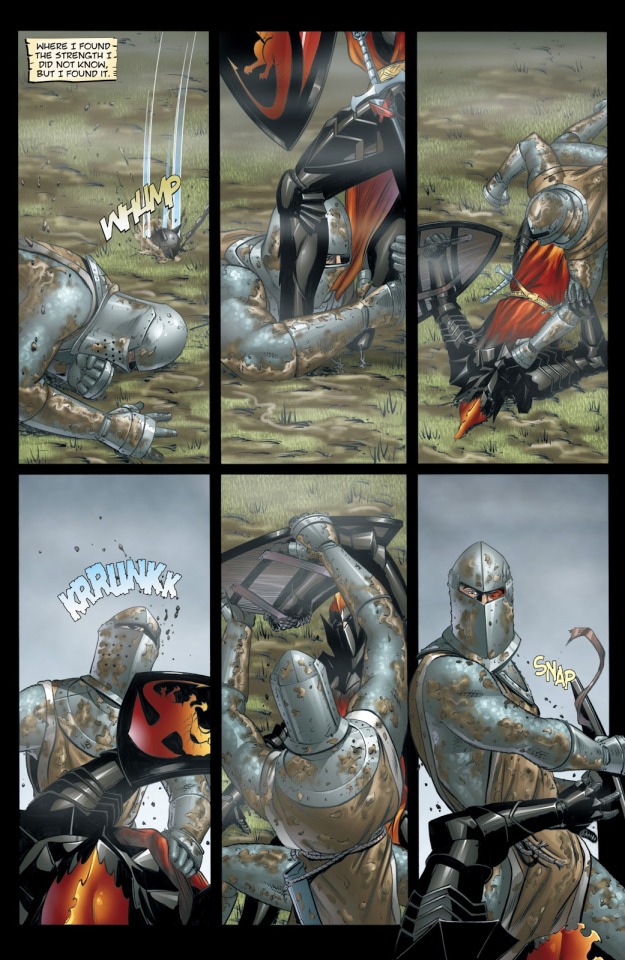
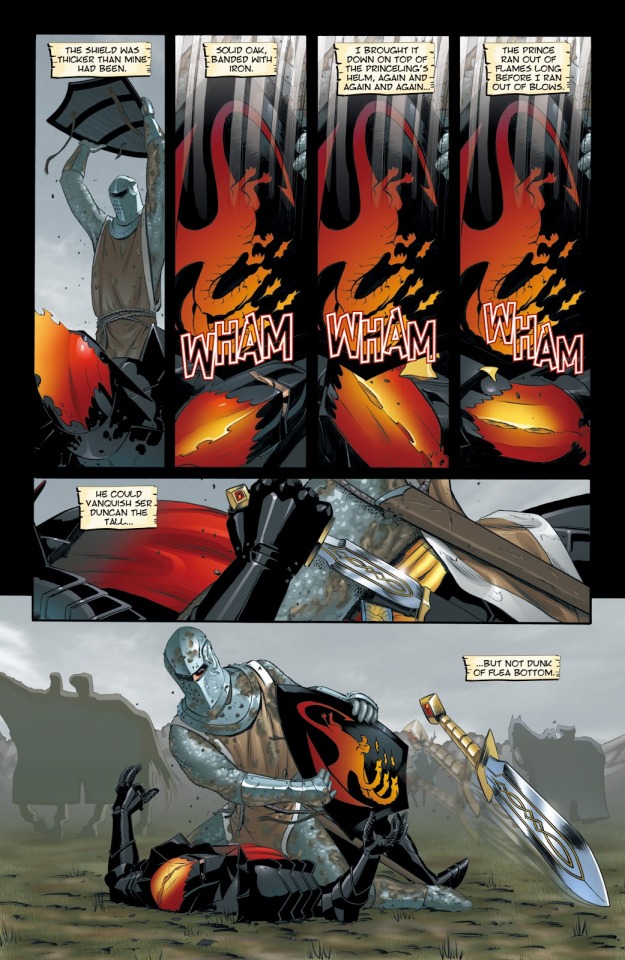
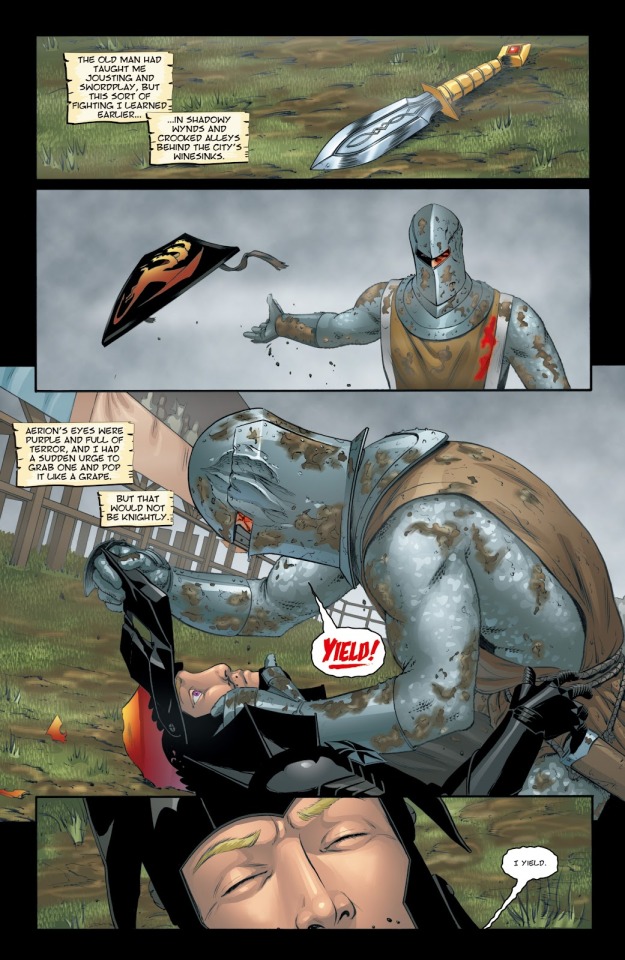


The Trial of Seven at Ashford Meadow!
The Hedge Knight #6
#a song of ice and fire#ser duncan the tall#aerion targaryen#prince baelor targaryen#lyonel baratheon#raymun fossoway#humfrey hardyng#humfrey beesbury#robyn rhysling#maekar targaryen#prince daeron targaryen#steffon fossoway#kingsguard#willem wylde#donnel of duskendale#roland crakehall#matt reads a thing#i posted this
49 notes
·
View notes
Note
The thing I find saddening about Ser Barristan is how impressive he is and he’s a good man under his KG armour, and in his head we can see he’s quite wise and humbld on the point of insecure. However, as KG he let foul things happen as did many others, to the point it’s extremely complicit in all areys brutal murders and is cowardice. Do you think it’s the culture of the 7 kingdoms, or something else that produces high pressure to knights of the KG’s complicit obedience? When did it start IYO?
Well, knights in Westerosi culture are actually supposed to be warriors that fight for goodness, as outlined in their knightly oaths, to be brave, just, defend the weak, the young, all women, etc., emphasized well by Ser Duncan defending Tanselle-Too-Tall from Aerion Brightflame. Similarly, as we see with Brienne swearing herself as Catelyn’s sworn shield, there is an obligation for the recipient to order “no task that would lead to dishonor.” So in truth, the Kingsguard is the opposite of the Westerosi ideal for knighthood, men who allow the mighty to prey on the defenseless, who refused to stand up for honorable conduct, and willingly followed orders that were dishonorable.
This didn’t start with Aerys II though. Aerion Brightflame used his status as a royal to obligate defense of his right to assault Tanselle-Too-Tall from Roland Crakehall, Willem Wylde, and Donnel of Duskendale. Aegon IV used the Goldcloaks as his personal kidnap-and-rape squad to predate on the women of King’s Landing, none of the Kingsguard knights followed the charge in their oaths to “defend all women.” The Kingsguard of both Aegon II and Rhaenyra routinely engaged in barbarism on behalf of their chosen monarch in the Dance of the Dragons.
Certainly, no one lives up to their ideals and the Kingsguard are far from the only knights to dishonor their cultural position and ideals emphasized by the knightly oaths (after all, scourge of the innocent Maegor, arch-rapist Aegon IV, and cackling madman Aerys II were all knights). So part of it is endemic to the power dynamics and structures that exist in Westeros and the people within it that support it, enforce it, and perpetuate it at all levels, and at the highest levels, where the most harm can be done, we see the same silence that becomes worse for all the harm that it does.
Even Barristan is notably skewed, he’s hardly a good man beneath the Kingsguard armor. Barristan, for example, romantically looks toward Rhaegar and uses him as a means to absolve him of his support for Aerys II, because if Rhaegar wasn’t, then Barristan enabled Aerys all those years for nothing, and he’s not emotionally strong enough to admit that.
Thanks for the question, Anon.
SomethingLikeALawyer, Hand of the King
87 notes
·
View notes
Photo
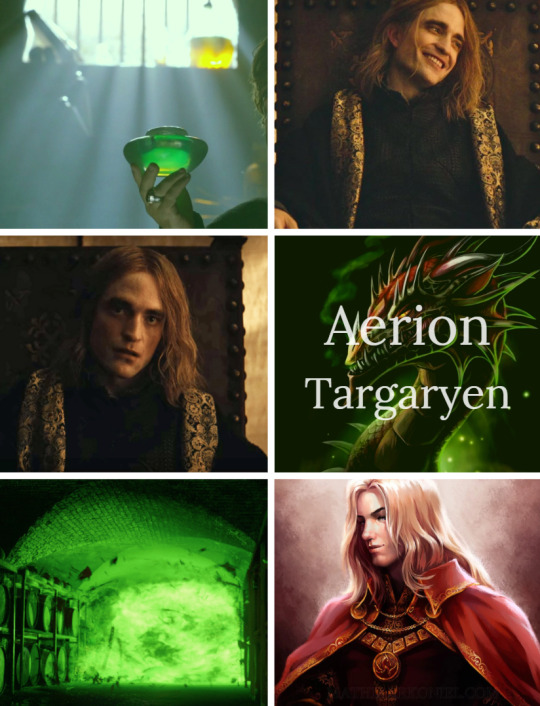
El príncipe Aerion Targaryen, apodado Aerion Llamabrillante o Aerion el Monstruo, fue el segundo hijo del rey Maekar I Targaryen y Lady Dyanna Dayne. Su emblema personal era el dragón tricéfalo Targaryen de gules, con dos de las cabezas amarilla y naranja respectivamente, en campo de sable.
Aerion es uno de los ejemplos más representativos de la locura latente de la Casa Targaryen. Cruel y arrogante, pensaba que era un dragón en forma humana. De acuerdo a Raymun Fossoway, el príncipe era toda cortesía y sonrisas delante de su padre, pero mostraba su verdadera naturaleza y carácter delante del resto de personas.
Siendo jóvenes, en una ocasión arrojó al gato de su hermano Aegon a un pozo, lo que le valió el odio de éste. En otra, visitó a Aegon en su habitación durante la noche, poniéndole un cuchillo en sus partes íntimas y bromeando acerca de que podría hacerle convertir en una hermana con la que poder casarse.
En 209 d.C., Aerion viajó a Vado Ceniza para el torneo que se celebraba. Allí confundió Ser Duncan el Alto con un mozo de cuadras, ordenándole que se ocupara de su caballo. Aerion parecía a punto de desafiar a su primo Valarr Targaryen en una justa, pero finalmente se decantó por Ser Humfrey Hardyng. El príncipe Aegon, escudero de Duncan bajo la identidad de Egg, quería que Humfrey matara a Aerion. Aerion mantuvo baja su lanza y empaló al caballo de Humfrey, dejando a la montura morir en una dolorosa agonía, lo que Aegon consideró intencional. Tras este incidente, el prínciper Aerion fue descalificado, y Ser Humfrey acabó con la pierna rota al caérsele encima su propio caballo.
Aerion se sintió insultado por un espectáculo de titiriteros en el que se representaba la muerte de un dragón. Aerion atacó a los titiriteros, rompiendo los dedos de una chica llamada Tanselle y destruyendo las marionetas. Duncan fue arrestado tras golpear y patear al príncipe. Después de que el príncipe Baelor Targaryen le recordara a Duncan que podía solicitar un juicio por combate, Aerion solicitó un juicio de Siete. Aerion sobornó a Ser Steffon Fossoway, uno de los campeones iniciales de Duncan, con la posibilidad de conseguir un señorío, para unirse al bando de los acusadores. Uniéndose a Aerion, estaban su hermano Daeron, su padre el príncipe Maekar, y tres caballeros de la Guardia Real, Ser Willem Wylde, Ser Donnel del Valle Oscuro y Ser Roland Crakehall. El tío de Aerion, el príncipe Baelor, se unió al bando de Duncan.
Durante el juicio, Aerion cargó contra Duncan y lo sacó de su montura con un lucero del alba. Duncan se negó a ceder, y utilizó sus habilidades para derrotar al príncipe en un combate cuerpo a cuerpo. Duncan obligó a Aerion repetir que retiraba su acusación ante Lord Ashford, poniendo fin al juicio. Baelor Rompelanzas murió por las heridas recibidas en el transcurso del juicio de Siete. Tras terminar el torneo, su padre Maekar lo envió a Lys, donde se quedó por unos años. Es posible que haya engendrado algunos bastardos durante su estadía.
Durante su exilio se unió a los Segundos Hijos. Posteriormente regresó a Poniente en algún momento antes de 219 d.C., año en que estalló la Tercera Rebelión Fuegoscuro y en la que participó activamente.
En el 232 d.C. su prima y esposa, la princesa Daenora Targaryen, le dio un hijo, Maegor. Ese mismo año Aerion murió al beber una copa de fuego valyrio, creyendo que se transformaría en un dragón. Su hijo, aun muy pequeño, luego fue olvidado en asuntos de sucesión. Poseía un huevo de dragón con vetas doradas y plateadas.
Prince Aerion Targaryen, nicknamed Aerion Brightflame or Aerion the Monster, was the second son of King Maekar I Targaryen and Lady Dyanna Dayne. His personal emblem was the Gules Targaryen three-headed dragon, with two of the heads yellow and orange respectively, on the saber field.
Aerion is one of the most representative examples of the latent madness of House Targaryen. Cruel and arrogant, he thought he was a dragon in human form. According to Raymun Fossoway, the prince was all polite and smiles in front of his father, but he showed his true nature and character in front of other people.
When they were young, he once threw his brother Aegon's cat into a well, which earned him his hatred. In another, he visited Aegon in his room during the night, putting a knife to his private parts and joking that he could make him become a sister to marry.
In 209 AD, Aerion traveled to Ashford for the tournament that was being held. There he mistook Tall Ser Duncan for a groom, ordering him to take care of his horse. Aerion looked about to challenge his cousin Valarr Targaryen in a joust, but ultimately settled on Ser Humfrey Hardyng. Prince Aegon, Duncan's squire under the identity of Egg, wanted Humfrey to kill Aerion. Aerion kept his spear down and impaled Humfrey's horse, leaving the mount to die in painful agony, which Aegon deemed intentional. Following this incident, Prince Aerion was disqualified, and Ser Humfrey had his leg broken when his own horse fell on him.
Aerion was insulted by a puppeteer show depicting the death of a dragon. Aerion attacked the puppeteers, breaking the fingers of a girl named Tanselle and destroying the puppets. Duncan was arrested after hitting and kicking the prince. After Prince Baelor Targaryen reminded Duncan that he could request a trial by combat, Aerion requested a trial of Seven. Aerion bribed Ser Steffon Fossoway, one of Duncan's early champions, with the possibility of securing a lordship, to join the accusers' camp. Joining Aerion were his brother Daeron, his father Prince Maekar, and three knights of the Kingsguard, Ser Willem Wylde, Ser Donnel of the Dark Valley, and Ser Roland Crakehall. Aerion's uncle, Prince Baelor, joined Duncan's side.
During the trial, Aerion charged Duncan out of his mount with a morning star. Duncan refused to budge, and used his abilities to defeat the prince in hand-to-hand combat. Duncan forced Aerion to repeat that he was withdrawing his accusation from Lord Ashford, ending the trial. Baelor Spearbreaker died from wounds received in the course of Seven's trial. After finishing the tournament, his father Maekar sent him to Lys, where he stayed for a few years. You may have spawned some bastards during your stay.
During his exile he joined the Second Sons. He later returned to Westeros sometime before 219 AD, the year in which the Third Fuegoscuro Rebellion broke out and in which he actively participated.
In 232 A.D. his cousin and wife, Princess Daenora Targaryen, bore him a son, Maegor. That same year Aerion died while drinking a cup of Valyrian fire, believing that he would transform into a dragon. His son, still very young, was later forgotten in matters of succession. It possessed a dragon egg with golden and silver veins.
#aerion brightflame#aerion targaryen#maekar targaryen#dyanna dayne#maester aemon#daeron the drunken#aegon v targaryen#daenora targaryen#baby maegor#house targaryen
38 notes
·
View notes
Text
WIP - fixit

Mid-2019, after the disaster known as Season 8, I started writing my first J/B fanfic. I still haven’t finished it. It’s a fix-it and I read so so many good fix its that I got bored with the idea and moved on to modern AUs. I just reread a little of it because of the @jb-reading-series (which I’ve already recorded and scheduled so no redos, Hillary, leave it the fuck alone), and it’s good. I think? I should maybe try to finish it at some point.
Here’s an excerpt...
——————————————————
Jaime steps into a tub that’s been prepared for him in his room. Steam dances before his eyes and conjures vivid images of baths he’s shared with Brienne before. Her body curled in the corner of the large tub at Harrenhal, knees drawn to her chest with a look of disgust upon her face. Her body standing defiant, staring him down, water dripping down smooth planes and lean muscles. And then her body tensed, gaze locked on him, as he bares his secrets and his soul. [I trust you.]
Jaime remembers the small tub in her room at Winterfell, with little room to maneuver between them. Her torso arched forward as he ran soap across her back. Her body pressed against his. Legs straddling his hips, fingers running across his scarred chest as kisses get more and more heated—passionately coming together after a day of pretending that nothing had changed between them. Her body shuddering and quaking under his touch, calling out his name [Jaime...] in that way that broke his heart a little more every time.
Pressing the heels of his hands to his eyes, scrubbing away the sights and sounds of these other castles, Jaime realizes his bath has gone cool. He doesn’t move to get out but sits paralyzed—he doesn’t know what to do. He’s been in Tarth for a few days and Brienne has barely acknowledged him. He doesn’t want to push but if she doesn’t come to him, he doesn’t have much choice, does he? He doesn’t know how to handle himself. In truth, it’s been terribly strained and he’s been losing hope since the moment he arrived. Brienne’s never been effusive but she’s been especially cool and withdrawn. She’s keeping him at a distance and he has found few opportunities to be alone with her—few opportunities to even start to say all the things he needs to say. She has every right to be upset with him, but she doesn’t really know the whole story and he needs time to tell it.
And then there’s this guy. This fucking guy.
Wylde.
From some inconsequential house in the Stormlands.
Maybe it was naive or self-centered but Jaime had not expected to arrive in Tarth to find Brienne with a suitor. How can Lord Selwyn think this nothing of a man is worthy of his warrior of a daughter? He’s slight and simpering, and always underfoot. By the Gods, Brienne could crush him without mustering any strength at all. What could he possibly offer her besides meeting the absolute basic minimum requirements? [an heir—Jaime realizes that the minimum requirement would mean laying with Brienne to produce an heir, and his skin prickles with a panic he’s rarely felt].
Thinking about the way that Willem Wylde looks at Brienne, Jaime’s chest fills with a white-hot acid despite the cold water of the bath. If he had been jealous of that loud red-haired Wildling, this was something else entirely. He burned. Brienne didn’t look at Wylde with the same barely-concealed disgust she’d offered Tormund. She actually seems somewhat fond of Wylde, and it is breaking Jaime.
With fear and jealousy surging through his body, Jaime shoots out of the tub, dresses quickly, and sets out from his room to find Brienne, his strides so quick he nearly tumbles over his own feet. Inquiring at her chambers, he learns that she’s out strolling along the parapet facing the sea, apparently a nightly ritual. He finds her standing, leaning against the low wall, staring off at the stars. Pausing behind her, back against the castle wall for support, Jaime clears his throat. This elicits a small turn of the head from Brienne to acknowledge his arrival before she twists back to look seaward again.
——————————————————
Accidentally hit post on this when I meant to schedule it. Now I’m not sure if I can fix that so it’s posted early. Blah. I know it’s Tuesday.
[header graphic by @scoundrels-in-love]
29 notes
·
View notes
Photo
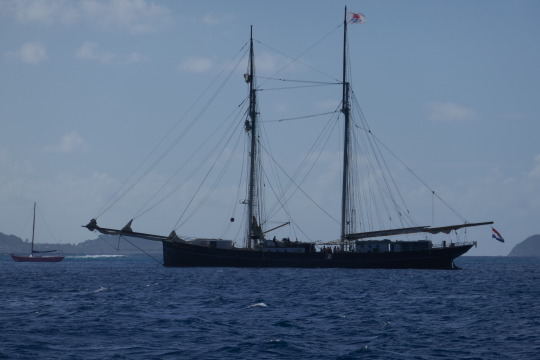
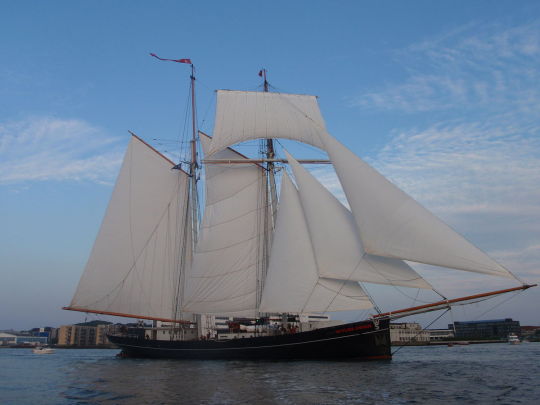

Ma photo d’un navire au mouillage n’est pas terrible, alors je suis allé en chercher d’autres sur internet.
Le Wylde Swan était à l'origine un harenguier à moteur à coque acier construit en 1920 à Howaldtswerke à Kiel en Allemagne. Ce type de chalutier a été conçu pour sa rapidité à rentrer au port afin de concurrencer les autres pêcheries.
En 1940, alors qu'il avait déjà été transformé par différents propriétaires, il est réquisitionné par la Kriegsmarine, puis récupéré en 1945 par la marine norvégienne. Alors que le navire était hors d’usage depuis longtemps, Willem Sluid, un constructeur de bateau, constate qu’il était apte à se convertir au voilier. En juin 2010, le navire est transformé en navire-école grée en goélette à hunier, la plus grande goélette à deux-mâts du monde, et navigue actuellement sous pavillon des Pays-Bas.
Voilà un rare exemple d’un bateau à moteur, reconverti secondairement en navire à voile.
Le Wylde Swan mesure 62 m de long, pour un maitre-bau de 7,3 m et un tirant d'eau de 3,5m pour un déplacement de 153 tonnes. Actuellement, il est grée en goélette à hunier, à deux mâts portant 7 voiles dont un hunier pour une surface de 1130 m2 de voilure, permettant une vitesse maximale sous voile de 14 noeuds (26 km/h). Il est également équipé d'un moteur diesel auxiliaire Caterpilar de 480 chevaux.
4 notes
·
View notes
Text
House Words Wednesdays: House Ball
Welcome to House Words Wednesdays! Each week, I take a House without known canon or semi-canon words and present what I think could make sense as that House’s motto. You’re free to suggest more as well, if your favored House has not yet been suggested; take a look at this link to see what has already been suggested, and shoot me a tweet or ask through Tumblr if you have another House you’d like to see.
House Ball is a noble House of the Reach, one of the more ancient families to spring forth (heh) from the land of the Gardener kings. According to legend, House Ball traces its ancestry back to Florys the Fox, a daughter of Garth Greenhand and the cleverest of his children. Shrewd Florys managed to keep three husbands without any learning the existence of the others: Houses Ball, Peake, and Florent all claim descent from one of these mutually cuckolded men. With the Peakes and Florents two of the very haughtiest families in the Reach (and two always eager to advance themselves), it stands to reason that House Ball was also, at some point, relatively lofty in the reacher aristocracy - not the same as the Redwynes or Hightowers, perhaps, but very possibly equal to, say, the Tarlys and Rowans, as well as their mythical cousins of Starpike and Brightwater.
The only known (well, legitimate) member of House Ball was Ser Quentyn Ball, master-at-arms in the Red Keep during the reigns of Aegon IV and Daeron II. It was Ser Quentyn who (presumably) trained Baelor Breakspear and Prince Maekar in arms, as well as Daemon Blackfyre (and might have finished the training young Aegor Rivers would have started at Stone Hedge). When a place in the Kingsguard opened during the reign of King Daeron, the king gave the honor to Ser Willem Wylde over Quentyn (to whom Aegon IV had supposedly promised a white cloak, and for which promise Quentyn had forced his wife to join the silent sisters). It was this snub which motivated Quentyn Ball to support Daemon Blackfyre: he was one of Daemon's most eager and successful commanders during the war, until he was shot down by a common archer on the eve of the Redgrass Field.
The Ball sigil is unfortunately rather boring: three white plates on a chevron red on a white field (Ser Quentyn took a much more rad personal sigil - a fireball blazing red and yellow across a night black field, in testament to his nickname, "Fireball"). So instead, I take for their words inspiration from their history: Pride in Our Blood (h/t to @racefortheironthrone for assistance with these words). Doubtless the Balls of the past had great pride in their blood, descended as they were from the cleverest of the great Greenhand's children (no less so than the Peakes and Florents have been). One can see a similar pride in Quentyn Ball - so sure, of himself and of the promise given him by Aegon IV, to gain a white cloak, and so proud that his offense at Daeron's refusal drove him to support a rival claimant. We also see a similar pride in the would-be son of Quentyn, Ser Glendon Flowers: the young man is so proud of his supposed lineage that he claims Fireball's personal sigil (despite his very possibly doubtful paternity) and finally smiles only when Egg guesses that he is the son of Ser Quentyn.
Tell me what you think of these words for the Balls. Next week we move out of extinct Houses and onto a House with just as much a thirst for war as Quentyn Ball.
The Queen Regent (NFriel)
38 notes
·
View notes
Text
Game of Thrones Willem Wylde
Willem Wylde is an unseen character in Game of Thrones. He is long dead when the series begins.
The post Game of Thrones Willem Wylde appeared first on 1337 Wiki.
Game of Thrones Willem Wylde published first on http://1337wikigaming.tumblr.com
0 notes
Text
Game of Thrones Willem Wylde
Willem Wylde is an unseen character in Game of Thrones. He is long dead when the series begins.
The post Game of Thrones Willem Wylde appeared first on 1337 Wiki.
Game of Thrones Willem Wylde published first on https://1337wikigaming.blogspot.com
0 notes
Text
Game of Thrones Willem Wylde
Willem Wylde is an unseen character in Game of Thrones. He is long dead when the series begins.
The post Game of Thrones Willem Wylde appeared first on 1337 Wiki.
0 notes
Note
Why did Daeron II deny Quentyn Ball a white cloak? Was it because he wanted to reward Willem Wylde for something or simply some kind of dislike for Wylde? Do you think it's possible that Daeron saw Ball's forcing his wife to join the Silent Sisters as something akin to Aegon IV's abuse of Naerys, and refused to reward it?
We don’t know, and probably won’t until Fire and Blood II, even then we might not. Daeron seemed to be making a concentrated effort to win over the Stormlands though, with Baelor’s marriage to House Dondarrion, Elaena’s marriage to House Penrose, it could have been a political strategy to secure himself with the region.
Thanks for the question, Anon.
SomethingLikeALawyer, Hand of the King
10 notes
·
View notes
Note
How do you think the Baratheons felt about the construction of Summerhall?
I think if the Baratheons felt annoyed at it, they kept that to themselves. House Baratheon had felt royal disfavor and worked to alleviate it following the Dance, as we see in the worldbook:
As the years passed, and king followed king upon the Iron Throne, these old rifts were forgotten, and the Baratheons came to serve the crown faithfully once more…until the Targaryens themselves put that loyalty to the test.
However, I think when Prince Baelor was betrothed to the Dondarrions and Willem Wylde brought into the Kingsguard, the Stormlands were starting to see coalition building at the hands of Daeron II. We don’t see a Baratheon in that, but the Baratheon sided with the Reds over the Blacks, so I think the Baratheons did not care overly much. They likely received a boon for the use of the land, and any kings or princes vacationing at Summerhall would be prime chance for Baratheon access (guesting them at Storm’s End on the way to and from).
Thanks for the question, Anon.
SomethingLikeALawyer, Hand of the King
15 notes
·
View notes
Note
Is there a difference in naming between different regions of westeros?
Yes and no. Yes in the sense that, in certain regions (particularly within certain families), certain names and naming conventions are going to dominate. Virtually every generation of House Stark, for example has a Brandon, with a smattering of Benjens and Ed- names for boys and Ly- names for girls. House Lannister loves its Ty- names, of course, but also its J/soft G names (Jason, Jaime, Joanna, Gerion, Gerold, etc.) and its soft C names (Cersei, Cerelle, King Cerion, etc.). The Greyjoys love names ending in -on for boys (from first Lord of the Iron Islands Vickon to the “Red Kraken” Dalton to all but two of the nine sons of Lord Quellon).
At the same time, many names seem to be shared amongst regions. The most famous Rickard to readers, for example, was surely Ned’s father Lord Rickard Stark, and there was indeed a historical King Rickard Stark and a few northmen named Rickard … but there have also been a Rickard Wylde (of the Stormlands), a Rickard Tyrell (of the Reach, obviously), and a Rickard Thorne (of the Crownlands). Willams/Willems can be found in the North, Stormlands, Riverlands, and Westerlands, while Steffons can be found in the Reach, Riverlands, Stormlands, Crownlands, and Westerlands. Olyvar, besides being the name of one of the most good-hearted Freys, was the name of both an Oakheart Kingsguard knight famed for being cut down by Dornishmen alongside King Daeron I and the short-lived younger brother of Prince Doran Martell of Dorne. Balon was given as a name to three known ironborn - including the late Lord of the Iron Islands - but is also the name of the Kingsguard knight Balon Swann, of the Dornish Marches. Most obviously, of course, there are quite a number of Jons and Jeynes now or formerly in Westeros. These are only a few examples, but they go to show that, while traditional family names (and politically advantageous namesakes) are certainly a thing, many names do not call only one region home.
79 notes
·
View notes
Note
Since when was Daeron II against Valyrian blood matches? Aelinor was a cousin of Targaryen descent, presumably via Baela or Rhaena. The Penroses likely aren't marchers. He could've chosen a maid from a number of Stormlands houses (or Reach) at least as principal as the Penroses. Why AElinor? He may have matched Aelor + Aelora too. Do you have a quote for the Reach winning Dornish lands? IIRC, there's none that Baelor took them away, or that Daeron I actually made Reach-matches for his hostages?
The Tyrells were put in charge of Dorne. From WOIAF:
Lord Tyrell, whom Daeron had left in charge of Dorne…
The Reach was given stewardship over Dorne, which means that Dornish lands are held by Reachmen as viceroys. For more information, see this piece.
Daeron I made no matches for his Dornish hostages. This is actually a point that @racefortheironthrone and I believe that Daeron II failed at in his treaty. Daeron II should have pushed for multiple Reachman/Dornish and Stormlander/Dornish marriages rather than just Maron to Daenerys, really looking toward building a single polity. It wouldn’t win over everyone, of course, but it would really demonstrate considerable effort toward building a singular Westerosi nation rather than appearing that Daeron sold out his constituency to win Dorne to the benefit of Dorne (and himself).
Now, as to Valyrian blood matches, look at his kids. Four sons, Baelor marries a Dondarrion (no blood relation), Aerys marries a Penrose (cousin), Rhaegel marries an Arryn (distant blood relation five generations back to Aemma Arryn), Maekar marries a Dayne (no blood relation). Why no closer matches? It’s clear that there are closer members available, from the kids of Oakenfist and Baela, the Hightowers and Rhaena of Pentos, etc. It’s clear Daeron is using marriage as a means of alliance and coalition building.
This matches Daeron II’s life. He already saw the disaster that was his mother’s marriage to her father, and the rumors that dogged his mother and uncle about suspected infidelity. Furthermore, he saw his own marraige to Meriah Martell as part of Baelor’s big push to end Daeron’s War of Dornish Conquest, and so it’s easy to see why he uses marriage as a way to bring people together in peace. It all stems from deep within his character.
Alright, you also raise the questions of, why the Stormlands, and why the Penroses, and these indeed, are two excellent questions Anon, cutting deep into the politics facing Daeron II in the wake of his Dornish treaty.
@goodqueenaly explained why the Stormlands very well: “the Stormlands is still the closest realm to the capital, and if the Stormlords were upset at the preferential treatment given to the Martells and their Dornish vassals, the quickest threat to King’s Landing would come from Storm’s End. Marriage between Aerys and his Targaryen-blooded Penrose cousin would be an ideal way to keep the non-marcher Stormlords on the side of the crown.” Combine that with the fact that the Reach lost their ability to administer Dorne, combined with the people they lost during the occupation of Dorne (the Oakhearts probably spat at the mention of Daeron II, given that Olyvar Oakheart died defending Daeron I), means that Daeron likely saw the effort as more likely to succeed if he went for the Stormlands rather than the Reach.
Now, why the Penroses? The Baratheons are a larger house, after all, you’d get more bang for your buck. As we can see, though, Daeron has made a pattern of attracting second-rate Stormlander houses to his side. Willem Wylde gets the white cloak, the Penroses and Dondarrions get royal marriages. However, it makes sense when you look at the key supporters of the Black Dragon. Sure, plenty of their support is based in the Reach, but there was also number two houses from the Seven Kingdoms, the Reynes, Yronwoods, etc. This makes sense, of course, the Lords Paramount can’t get any higher within their respective regions. So the Lords Paramount would be, absent a direct marriage, defenders of the status quo and thus nominally inclined to support the Red over the Black. Daeron is looking to build that secondary house network that will give him, in the worst case scenarios, a local force majority in the Stormlands, and expecting the Baratheons to fall in to the Reds because the risk of them losing their position (which they only gained from the Targaryens) to a family that supported Daemon Blackfyre.
Thanks for the question, Anon.
SomethingLikeALawyer, Hand of the King
18 notes
·
View notes
Text
House Words Wednesdays: House Wylde
Hello everyone!
I have a feature on the Tumblr called House Words Wednesdays. Each week, I take a House without known canon or semi-canon words and present what I think could make sense as that House’s motto. You’re free to suggest more as well, if your favored House has not yet been suggested; take a look at this link to see what has already been suggested, and shoot me a tweet or ask through Tumblr if you have another House you’d like to see.
House Wylde is the first of the two rainwood Houses I’m tackling, and fittingly, I wanted to make their words very rain themed. The rainwood is Westeros’ temperate rainforest, a soaking treasure trove of fur, timber, and amber. House Wylde in particular seems to have taking their rainy homeland to heart: their seat is called “Rain House”, while their sigil is a blue-green maelstrom on a golden field. The Wyldes themselves have little known history, although they’ve come up at a few key moments in Westerosi history: Jasper Wylde was the master of laws for Viserys I, who insisted that the law put a trueborn son before a daughter (and was executed by Rhaenyra for it); Willem Wylde was a knight of the Kingsguard, preferred over Quentyn Ball (who had supposedly been ensured a place by Aegon IV, and which preferment eventually prompted him to join Daemon Blackfyre). There was even a Wylde at the siege of Storm’s End during Robert’s Rebellion; Ser Gawen tried to sneak out and surrender, but was caught by Stannis and condemned to a cell, where he died.
So, with the rain-based theming of the House, I decided the Wylde words would be Rain Falls on All. Of course, literally it works to describe both the climate in which the Wyldes live and their ancestral seat’s name. Perhaps as well, like the maelstrom on their sigil, the Wyldes would want to warn their enemies that they, the steely rain, would fall upon any who challenged them. With these words as well, I wanted to convey a sense of uniform application of some elements of fate: highborn or low, no man escapes the rain, and the same rain falls on enemies and allies alike. The same law that Viserys in part relied on for his claim to the throne - that a male line must come before a female - must as well, in Jasper Wylde’s mind, apply to Rhaenyra, and nullify her royal claim. Every man must experience the trying times of rain, no less so than one from the rainwood; Ser Gawen failed to see the truth of that, seeking an escape from his troubles, and was punished for it.
Let me know what you think of these Wylde words. We stay in the rainwood next week, moving from the family of the maelstrom to the family of the owls.
The Queen Regent (NFriel)
44 notes
·
View notes